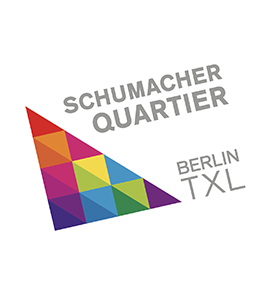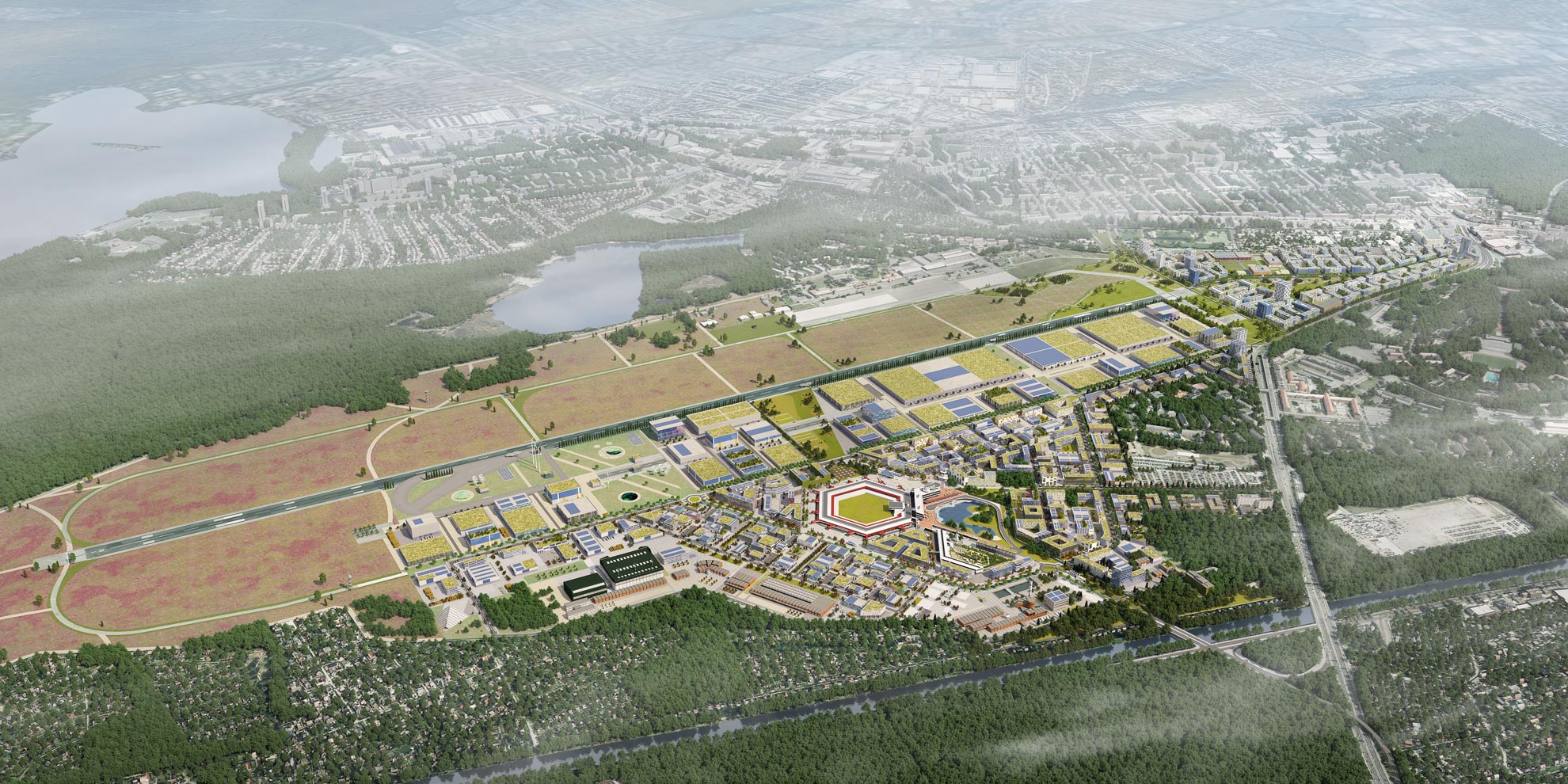The future on 500 hectares
Live on site
Discover the former airport and find out what’s going on here! Drop by our new Infocenter or book a tour of the site.
Press play!
What’s going on at Berlin TXL? Take three minutes to have a look. Our video takes you on a journey through the city of the future.
Imagine there’s a place where the city of tomorrow is emerging. Where ideas are springing up and jobs being created. Where life is colourful and living affordable. Where we can rediscover mobility and climate-neutral is standard. Where we think in terms of cycles, not consumption. Where nature isn’t ‘somewhere out there’ but here at home. Where how we are together matters and as a person you take centre stage.
This place is being created here: in Berlin TXL.
jobs
students
green space
homes
climate-neutral
Welcome!
With the closure of Tegel Airport, Berlin gained an exceptionally large amount of free space – and with it a unique historic opportunity: on the enormous site, the state-owned company Tegel Projekt GmbH is developing a new urban district from the ground up, a model district for sustainable urban innovation, Berlin TXL.
The common thread running through the plans for the site’s future use is the vision of a better city – better because it is cleaner and socially integrative; a city for the people – ultra-modern and innovative, and yet close to nature and respectful in its use of resources. New approaches and methods have fed into the planning process, and specialists from a wide range of disciplines are working hand in hand to develop holistic solutions that make Berlin TXL unique.
In 2021 the green light was given to the urban development project, which is among the largest and most ambitious of its kind throughout Europe. The district creates space for science and industry alongside thousands of urgently needed homes – surrounded by plenty of nature and recreation opportunities, 15 minutes away from the centre of Berlin.
The triad of science, research and industry on their own innovation campus is something special: here in the Urban Tech Republic, future urban technologies will be researched, developed, produced, tested and exported. Science and research meet industry and commerce, and start-ups meet investors, with everyone working together on solutions for the cities of the future. . The Berliner Hochschule für Technik will move into Terminal A with 2,500 students. Space for up to 1,000 large and smaller companies is being created in the commercial area and industrial park, providing 20,000 jobs.
The triad of science, research and industry on their own innovation campus is something special: here in the Urban Tech Republic, future urban technologies will be researched, developed, produced, tested and exported. Science and research meet industry and commerce, and start-ups meet investors, with everyone working together on solutions for the cities of the future. . The Berliner Hochschule für Technik will move into Terminal A with 2,500 students. Space for up to 1,000 large and smaller companies is being created in the commercial area and industrial park, providing 20,000 jobs.
Smart, affordable, and close to nature: in the Schumacher Quartier, more than 5,000 homes are being created on an area of 46 hectares, for over 10,000 people – along with nurseries, schools, shops and plenty of green space. Solutions for ecological construction, climate-neutral energy supply and the sensitive utilisation of water will be implemented here in addition to new concepts for low-traffic mobility and increased biodiversity. To ensure affordable living, only non-commercial actors are engaged in construction here.
Smart, affordable, and close to nature: in the Schumacher Quartier, more than 5,000 homes are being created on an area of 46 hectares, for over 10,000 people – along with nurseries, schools, shops and plenty of green space. Solutions for ecological construction, climate-neutral energy supply and the sensitive utilisation of water will be implemented here in addition to new concepts for low-traffic mobility and increased biodiversity. To ensure affordable living, only non-commercial actors are engaged in construction here.
The extensive landscape area of the Tegel urban heathland forms a bridge between the city and nature, and completes the pioneering concept of Berlin TXL. The state-owned company Grün Berlin GmbH is taking on the task of gradually transforming the former airfield and runway. A planned area of 220 hectares will be developed as a nature conservation area, offering an innovative open space with opportunities for recreational use and research.
The extensive landscape area of the Tegel urban heathland forms a bridge between the city and nature, and completes the pioneering concept of Berlin TXL. The state-owned company Grün Berlin GmbH is taking on the task of gradually transforming the former airfield and runway. A planned area of 220 hectares will be developed as a nature conservation area, offering an innovative open space with opportunities for recreational use and research.
Cité Pasteur and TXL Nord offer the potential for an additional 4,000 homes.
Cité Pasteur and TXL Nord offer the potential for an additional 4,000 homes.
The issues that drive us in Berlin TXL:
The challenges are big, but our ambitions are even bigger. The focus of Berlin TXL is on what keeps the growing metropolises of the 21st century alive.
Urban technologies and solutions:
ENERGY
It is not only concepts for the energy world of the future that are being developed in the Urban Tech Republic. With our low-exergy network we are already putting into practice an idea that goes far beyond decarbonising the energy supply. Especially for the heating and transport sectors, it paves the way for a future without fossil fuels.
WATER
Clean water is essential, making it a key issue for the Urban Tech Republic. At the same time, the Schumacher Quartier is designed as a climate-resilient sponge city, well prepared to withstand heavy rains, drought and heat. All the rainwater in the district is used or stored; nothing is lost.
MOBILITY
The future of mobility is green, efficient and safe. Concepts supporting this are being devised and implemented in Berlin TXL. Mobility hubs and cycle paths make the Schumacher Quartier largely car-free. In the Urban Tech Republic innovation park, researchers and companies develop and test new mobility solutions together.
RECYCLING
Making new from old: in Berlin TXL we are relying on intelligent cycles to utilise materials sustainably. Those that arise from unsealing the construction area are processed on site where possible and reused. We are intensively engaged in concepts for concrete renovation, cradle-to-cradle for construction materials, and ecologically oriented design concepts for streets, squares and paths.
NEW MATERIALS
Berlin TXL advocates consistently rethinking our understanding of new construction and raw materials. For example in the FUTR HUT, which launches in 2023: an innovation, production and collaboration location with the aim of making sustainable, climate-neutral construction affordable and marketable.
SMART INFRASTRUCTURE
The smart digitalisation of cities improves quality of life, conserves resources and makes urban living and economies more sustainable. Berlin TXL will act as a trailblazer for the capital on its way to becoming a smart city – a pivotal hub on this journey is the FUTR HUB, the competence centre for urban data.
BIODIVERSITY
Our society is becoming increasingly aware of the importance of biodiversity for people and nature. Based on our own biodiversity strategy, foundations are being laid in Berlin TXL to allow new, native animal and plant species to become established. The still emerging planning principle of Animal-Aided Design is also being used.
PARTICIPATION
Berlin TXL is not being created in a test tube, but has been enriched from day one by the input and feedback of the people who have joined us. Participation and collaboration are two essential factors in the success of Berlin TXL – now and in the future.
Pay us a visit!
Would you like to learn more about Berlin TXL? Then visit our new Infocenter or book our guided tour of the former airfield. We look forward to seeing you!
Still got questions?
In our FAQs you’ll find answers to all the important questions relating to Berlin TXL.


